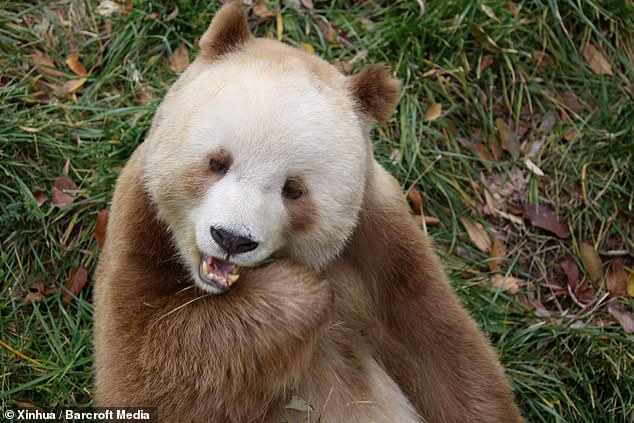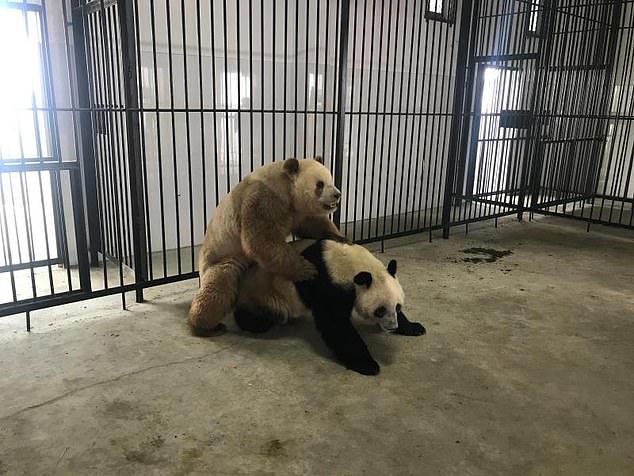Hailing from forests located within mountain ranges across China, the iconic giant panda has long captivated the world with its distinctive black and white fur.
However, amid the sea of monochrome fur, a rare sight occasionally emerges: a panda adorned in rich shades of brown.
For years, the origins of these unconventional pandas have baffled scientists and conservationists alike, with experts previously attributing their mutation to inbreeding or environmental factors.
Now, a groundbreaking study by researchers in Beijing, China, has shed light on this fascinating phenomenon, uncovering the genetic underpinnings behind the existence of brown pandas and dispelling the notion that inbreeding is the cause.
After examining the genetics of pandas in the wild and in captivity, scientists at the Institute of Zoology of the Chinese Academy of Sciences in Beijing have suggested that pandas with brown and white fur are the result of natural variation.
Hailing from forests located within mountain ranges across China, the iconic giant panda has long captivated the world with its distinctive black and white fur (file image)

For years, the origins of rare pandas with brown and white fur have baffled scientists and conservationists alike, but now scientists have shed light on this fascinating phenomenon.
Lead author Dr. Fuwen Wei, a professor of wildlife ecology and conservation biology at the institute, said better understanding the mutation could help inform efforts to breed brown and white pandas in captivity.
The first brown panda known to science was a female named Dan Dan, a sick bear found by a local ranger in Foping county in the Qinling Mountains of Shaanxi province in 1985.
The panda was kept in captivity at the Xi’an Zoo until its death in 2000, but surprisingly, since its discovery nearly four decades ago, there have only been 11 sightings of brown pandas, according to cnn.
Each sighting has been documented through official news reports or through personal accounts shared with the authors of the latest study that appeared in PNAS magazine on March 4.
Led by a team of geneticists and conservationists, the study delved into the intricate DNA of brown and black and white pandas, including analyzing hair samples from bears in several regions of China.
The researchers studied Qizai, a male brown panda rescued as a cub in 2009 from the Foping National Nature Reserve in Hanzhong. He is currently the only brown panda in captivity.
When compared under a microscope to hair samples from three black and white pandas, Qizai’s brown fur had fewer and smaller melanosomes, tiny structures found in cells responsible for skin and hair pigment in mammals.
When reconstructing his family tree, researchers discovered that Qizai’s mother and father were black and white pandas, while Qizai’s son, born in captivity in 2020, was also born with a black and white coat.

Researchers studied Qizai (pictured), a male brown panda rescued as a cub in 2009 from the Foping National Nature Reserve in Hanzhong.

The researchers were able to show that Qizai’s parents and son had one copy of the recessive trait in a gene known as Bace2, while Qizai had two copies.

The findings have also shown that the first brown bear discovered, Dan Dan, had the same recessive trait.

Dr. Fuwen Wei has said that better understanding the mutation could help inform efforts to breed brown and white pandas, like Qizai (pictured, left) in captivity.
The scientists studied genetic information, such as stool and blood samples, from Qizai’s family members and compared it with that of 12 black and white pandas from the Qinling Mountains and 17 black and white pandas from other regions of China.
While none of Qizai’s immediate family members had brown fur, researchers were able to show that his parents and son all had one copy of the recessive trait in a gene known as Bace2, while Qizai had two copies.
Thanks to the analysis of a tissue sample stored for more than two decades in ethanol, scientists were also able to study Dan Dan’s genome, and the findings have shown that the first brown bear discovered had the same recessive trait.
However, it is not clear what causes the genetic mutation, and Dr. Wei suggests that it could be related to the specific environment of the Qinling Mountains, which have a different climate than Sichuan.
He added: “It is more likely to be the result of natural variation than inbreeding.” Our kinship analysis indicates that Qizai’s parents are not closely related.
In 2022, Qizai, now 15 years old, naturally mated with a partner for the first time at a Chinese breeding center.

